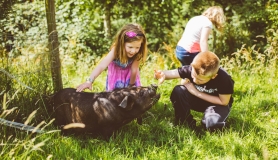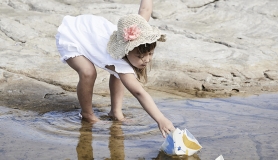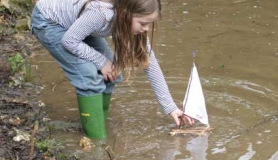Since choosing the liveaboard cruiser way of life we’ve been pleasantly surprised by the number of families doing the same thing as us. There seem to be a lot more people taking to the seas these days, and long-term global sailing on a yacht no longer needs to be a dream saved up for one’s retirement.
Over three years ago we threw off the docklines in Falmouth, England and began our adventure. We left with the intention of sailing around the world in roughly two years and finally returning to London with some amazing memories. We rented our house, spent the money we’d put aside for an extension on a boat instead and set off with a little sailing experience and a very limited understanding of boat maintenance but with a healthy amount of optimism. We joked about returning with children!
Everything was about educating ourselves: sailing better and more efficiently, interpreting the weather more capably, becoming more skilled and less flustered when it came to running repairs. We became a great team of two and really developed as sailors.
Having rushed through our first 8,000 miles we ended up staying in Panama for the following eight months. We only really started to appreciate what living on the boat truly meant once we slowed down a bit. We were enjoying ourselves and the new-found freedom that long-term cruising offered seemed to suit us.
Starting a family
I was 30 and James, my husband, was 42 when we started talking about starting a family. The idea of the ‘normal’ life back in London with kids, a home and a traditional career seemed less and less relevant to us. James would need to be working longer hours to support our new family. We’d be doing something which is meant to be about togetherness, but the way in which we’d have to go about it seemed lopsided, separate and contradictory. We’d acclimatised to a life where we were happily spending twenty four hours a day in each others’ company, working as a well-functioning team, and modern parenting simply didn’t make sense.
There’s a traditional way of going about having babies on land, which seems to also involve buying an immense amount of gear. But where was the manual for expectant parents on a yacht? How do you baby-proof and what equipment is really necessary in a home where space is at a premium? What do you do once your little ones are crawling, walking or potty-training?
Like any would-be parents and all sailors we realised that some plans cannot be entirely controlled. We had no idea if we would even get pregnant straight away so we needed flexibility in our options. While still in Caribbean Panama we agreed that if we were lucky enough to get pregnant soon that attempting our next ocean passage during our first pregnancy might not be wise so we’d put off our cruising of the South Pacific for another year. By the time we went through the Panama Canal in January I was already at the end of my first trimester so, we turned right, explored Pacific Central America and fought against wind, current and all seafaring common sense in order to reach Banderas Bay in Mexico.
Preparing for birth
We spent three months sailing over two and a half thousand miles to where we planned to give birth and had to deal with a medical system in a language we’d only just started learning.
‘Boat kids’ are a great advertisement for the benefits of sailing with children. However, the advantages are not always necessarily to the sailing itself, but to the way of life as a whole. Cruising children are generally friendly, conversational, undaunted by interactions with other adults and relatively hardy. Without exception, children we’ve met whilst crusing have looked us in the eye when they speak and can scramble up the mast, onto the boom or jump off the boat with the ease and coolness of one who has being doing so their whole lives.
Managing with a newborn
A boat baby, however, seemed like a more overwhelming prospect. When our daughter was born we had the boat in a marina just to get used to the new arrival in a more controlled way. The usual kit - a crib, a stroller and a carseat weren’t going to work onboard so we focussed simply on strategies for how to handle sleeping, feeding, carrying and changing. Surprisingly, all of these are fairly simple with a newborn. Our cabin has a wall-to-wall bed so was perfect for co-sleeping with no worry of her falling out. I breastfed her, so that meant there were never any bottles to sterilize or formula to buy. A sling or soft-structured carrier was the easiest way of getting her on or off the boat and for helping to lull her to sleep as we walked the docks. We chose to use cloth nappies and had plenty of water for laundry, whilst moored in the marina. We began to think that we’d completely got the hang of being boat parents.
But two things changed that: the boat moving and the baby moving. As savvy sailors we’d managed to time our new arrival for hurricane season. But, once the seasons changed there was no need to stay in the marina, plus we couldn’t afford the high season rates so we had to start cruising again. Resuming our lives at anchor with an infant meant that every trip ashore needed a strategy. We had to have a bag packed full of nappies, wipes, snacks and extra bits of clothing. This was when we started using a baby lifejacket, as anchorages are not necessarily still. Even when your journey ashore is calm the wind can kick up, giving you a wet and bumpy ride back, which is daunting with a baby. We had to get used to being at the helm with her strapped to us in the carrier, learn how to change nappies underway and find a safe place for her to doze in, taking into account the heel of the boat and unpredictability of the sea.
However, all of that seems simple in retrospect once your baby becomes mobile. No longer can you turn your head away and expect the child to be in the same place when you look back.
“We spent three months sailing over two and a half thousand miles to where we planned to give birth”
Getting extra help
Our first passage as a family was the 26-day, 2,850 mile crossing of the Pacific Ocean from Mexico to the Marquesas in French Polynesia. It was then that our 8 month old daughter learned to crawl which meant that I saw a lot less sea and a lot more of the cabin than before. However, we made one major concession and enlisted an extra member of crew. It was a smart decision and one that we’ve found is a good compromise for those who choose not to give up on their larger sailing goals. After arriving in French Polynesia we were fortunate enough to pick up casual crew again to lend an extra hand during our passages across the South Pacific. It worked well for us as it gave extra sailing support to James, which makes up for my energies being needed elsewhere.
It also provided a much-needed relief for the work onboard as, in truth, sailing with an infant is definitely hard. Yet the payoff for the effort is a huge gain. Our daughter has had two engaged and attentive full-time parents since the moment she was born. My husband has witnessed every milestone; first steps and first words, and is a present and supportive teammate for me as we adjust to being parents. Touching base with family and friends back home makes us conscious of how unusual that is for a father and has meant that we’ve avoided that imbalance that we were worried was an inevitable part of early parenthood.
Our one major change to the boat has been the addition of ‘baby netting’ all along the guardrails, pushpit and bow. This allows Rocket the freedom to roam without needing a parent hovering over her. A boat is already a remarkably baby-proof environment; there are rounded edges, drawers are fitted with features that stop them flying out at sea, and there are no live electrics or other dangers at toddler-height as they’d be a liability out on the water.
Rich educational opportunities
The issue of what to do when your children reach school age is much more straightforward than might be assumed. A boat is a highly complex, rich and stimulating environment for a child and the schooling options available to cruiser’s offspring seem relatively simple. Widespread internet access in even the most remote islands allows for distance or correspondence learning to be an effective method of teaching. Quite often the parents choose for the kids to go into the local school in whatever town, whatever country they drop the hook in for a time, which allows them to have immersion learning, meet other children and swiftly become more adept at a new language than their parents. There’s also the option of choosing a more instinctive curriculum generated by the circumstances of the journey itself: learning about the French language, Captain Cook, European foreign policy or even local species of reef sharks and manta rays when sailing in Tahiti for example.
Just because they’re still too little to hoist the mainsail or stand a watch at the helm doesn’t mean that children can’t get involved. Watching for the mainsail luffing, helping catch a fish, answering questions about the figures on the instruments or identifying a bird can all help younger kids to join in. We’ve known children as young as six that steer competently under engine. As they get older so their roles and responsibilities can evolve and the knowledge that they’re contributing more to life aboard gives a great sense of satisfaction.
It’s true that the realities of sailing with a baby can be tough at times and it’s made us adjust our sailing strategies and approach our cruising plans differently, thinking in terms of what will work best and be most comfortable for all of us. Our daughter now has her first ocean crossing under her belt and has even learned to walk despite fairly lively sea conditions. We don’t wish to always sail with extra crew so we’ll probably have a year or two of coastal rather than ocean sailing. But as long as we’re enjoying it we can keep a happy balance of staying true to our cruising couple past, while being full-time parents as well.
We’re planning to have our second boat baby in New Zealand. Just how long and how far we’ll be sailing as a family we don’t know but we’re confident that a life afloat is working well for our young family and the other children in our cruising fleet encourage us that there are even more enjoyable times ahead. We can’t wait to see how our littlest crew member grows and love that by doing it this way neither one of us misses a moment of that journey.
Jessica and James live aboard a cruising yacht with their daughter, Rocket, one, who was born in Mexico. They are expecting their second child. Over 18,000 miles and 32 countries since they set off you can follow their progress at water-log.com







